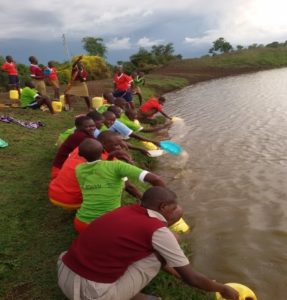Protect and strengthen the rights of children with access to safe water and sanitation in schools in the county of Homa Bay, Kenya
State of progress : Completed | Number of beneficiaries : 6500 people including 516 children and 26 teachers
Project duration : 1 year
Place : Kokoth Kateng location Karachuonyo North Constituency, Homa Bay County, Kenya
local partner
ANPPCAN: African Network for the Prevention and Protection against Child Abuse and Neglect
ANPPCAN is a Pan African organization defending the rights of children registered in Kenya as an NGO No. OP.218 / 051/9264/61, under Article 10 of the Law on the coordination of organizations NGOs. ANPPCAN was founded in 1986 in Enugu, Nigeria, at the first African Conference on child abuse and child neglect. It has an observer status with the African Union and a similar status with the African Commission on Human Rights and Peoples. The focus is on preventing the worst forms of child labor and rehabilitation of child rights.
ANPPCAN has already successfully conducted a Water and Sanitation project with PADEM and this project here is this continuity. This previous project was located Kokidi, neighborhood riding Karachuonyo, Homa Bay County, Kenya, and was Otaro primary school and secondary school Mixed Otaro (both located in the district of Karachuonyo) and neighboring communities. The final evaluation of the project reports that: “The project led by ANPPCAN was overall very well: the objectives were achieved in time and within budget. The interest it generated a very positive element to ensure sustainability. ”

Context
Children of Kenya (0-18) account for over half the total population of 38 million inhabitants (National Census of Kenya, 2009), and 20% of the population is under 5 years. Children are among the most marginalized and vulnerable members of Kenyan society, and therefore, their rights, in particular health and education, must be safeguarded and protected.
Today, access to clean water and adequate sanitation continues to be a threat to human health in Kenya. In 2003, an estimated 1.6 million deaths were attributable to unsafe water and sanitation, including lack of hygiene, and 90% of this burden is concentrated on children under the age of five. Expanding access to clean water, hygiene and sanitation is essential to reduce water-related diseases and improve the well-being of a large part of the world’s population. It is also an essential contribution to economic development and poverty reduction.
School infrastructure is a major obstacle to improving access to primary education in the country. The introduction of free primary education in 2003 from secondary education in 2007 resulted from a rapid increase in the school population, which puts great pressure on already existing inadequate water and sanitation in school infrastructure.
In Kenya, only a third of schools have clean water sources in their complexes and child-friendly latrines. Although most schools have separate and gender-specific latrines, the majority of them do not meet the health standards ratios for boys or girls (the recommended latrine ratio is 25: 1 (girls) and 30: 1 (boys)). Diseases spread quickly in tight spaces with limited ventilation, where hand washing facilities or soap are not available, and where toilets are in poor condition. Too often, schools are places where children get sick.
The mission / activities
Goal: Improve the living conditions, particularly health and education of children in targeted schools and communities in the county of Homa Bay, Kenya.
Specific Objective: To observe and promote the rights of children to education and health, through better access to water and sanitation in schools, as well as hygiene education in County Homa Bay, Kenya.
- Construction drilling solar pump, water tanks and safe water supply points
- Construction of latrines and hand washing stations
- Setting up of WASH committees to ensure sustainability of the facilities. Sale of water by these committees to ensure the maintenance of tanks and latrines and provision of hygiene products in schools
- Awareness community and child hygiene and health
Beneficiaries
The project will directly benefit approximately 6 542 persons:
- Children: The first direct beneficiaries of this project are the children of the two targeted schools that will benefit from the construction and renovation of health facilities, as well as training and awareness programs. In primary school, there are 346 children (157 boys and 189 girls) aged 5 to 14 who attend classes. In high school, there are 170 children (82 boys and 88 girls), aged 15 to 19 years.
- Community: Parents and members of neighbouring communities benefit from safe water sold by WASH committees and will be directly integrated into prevention and awareness activities. Parents are already involved in the project because they were consulted during the project planning phase to look for ways to bring water near children. Parents will also be involved in the rehabilitation and renovation of latrines and toilets and efforts will improve health and education needs of their children. We can estimate the number of parents and members of the community benefiting from the project some 6 000 people.
- Academics and school employees: teachers and two school workers also benefit directly from project activities. They will be the main actors of change towards greater respect for children’s rights in schools. There are 9 teachers, (3 women and 6 men) working in primary schools, and 13 teachers (5 teachers 9 women and 8 men) in high school. Each school also has a school director and deputy director. We can also count on support staff that helps primary school and three in high school. There will be 26 teachers and workers benefit directly from the project.
